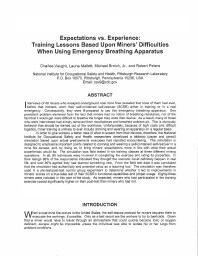Mining Publication: Expectations vs. Experience: Training Lessons Based Upon Miners' Difficulties when Using Emergency Breathing Apparatus
Original creation date: April 2004
Authors: C Vaught, LG Mallett, MJ Brnich, RH Peters
NIOSHTIC2 Number: 20025161
J Int Soc Respir Prot 21 2004 (Spring/Summer); :49-59
Interviews with 48 miners who escaped underground coal mine fires revealed that, before those incidents, none of them had ever worn their self-contained self-rescuer (SCSR) either in training or in a real emergency. Consequently, they were ill-prepared to use this emergency breathing apparatus. One persistent problem stemmed from the fact that miners had no notion of breathing resistance nor of the fact that it would get harder to breathe the longer they wore their device. As a result, many of the interviewees had simply removed their mouthpieces and breathed ambient air. This is obviously behavior that should be trained out of the workforce. Unfortunately, because of high costs and difficult logistics, miner training is unlikely to regularly include donning and wearing an apparatus. To give workers a better idea of what to expect from their devices, researchers from the National Institute for Occupational Safety and Health developed a tabletop (paper-and-pencil) simulation based on actual predicaments that evacuees had reported encountering. The simulation is designed to emphasize important points about donning and wearing an SCSR in a mine fire escape and thus bring miners' expectations more in line with what their actual experiences would be. The simulation was field tested in six training classes at three different mining operations. In all, 99 individuals were involved in completing the exercise and rating its properties. Eighty-eight percent of the respondents indicated that they thought the scenario could definitely happen in real life, and over 80% agreed that they had learned something new. From the field test data it was concluded that the simulation had authenticity and potential value as a teaching tool. The simulation was therefore used in a pretest/posttest control group experiment to determine whether it led to improvements in miners' scores on a true/false test of their SCSR's functional capabilities and proper usage. Eighty-three miners were included in this part of the study. As expected, miners who had participated in the training exercise scored significantly higher on their posttest than those who had not.

NIOSHTIC2 Number: 20025161
J Int Soc Respir Prot 21 2004 (Spring/Summer); :49-59
- Age Awareness Training for Miners
- How to Operate a Refuge Chamber: A Quick Start Guide
- I Can't Get Enough Air! Proper Self-contained Self-rescuer Usage
- Pillar Stability Issues Based on a Survey of Pillar Performance in Underground Limestone Mines
- Recommendations for Refuge Chamber Operations Training
- Self-Contained Self-Rescuer Field Evaluation: Seventh-Phase Results
- Smoke, Carbon Monoxide, and Hydrogen Chloride Production from the Pyrolysis of Conveyor Belting and Brattice Cloth
- Technology News 497 - "You Are My Sunshine": A New Video Release From NIOSH on the Sunshine Mine Fire
- Technology News 513 - Coaching Workshop for On-the-Job Trainers
- Technology News 549 - MFIRE 3.0 - NIOSH Brings MFIRE into 21st Century